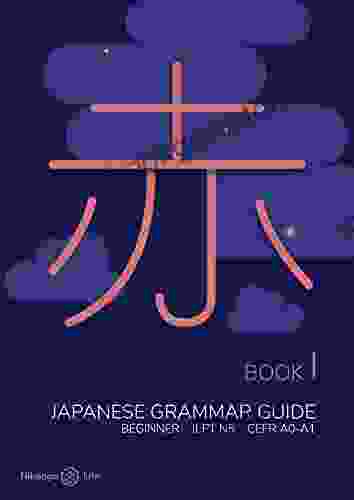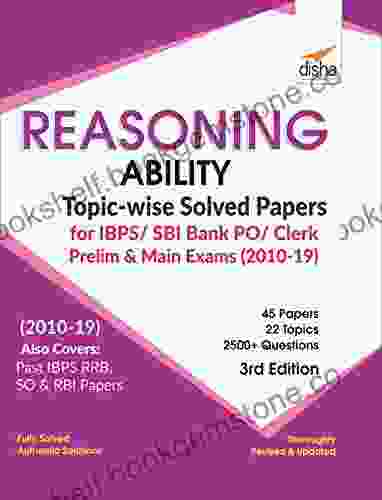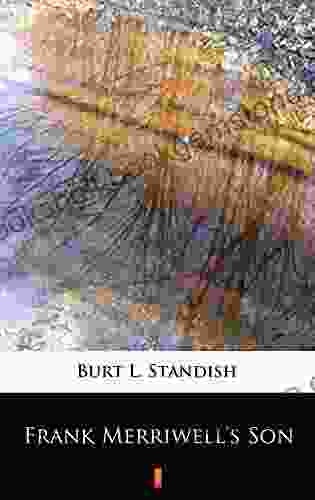Navigation and Logic on Puluwat Atoll: A Study in Micronesian Ethnomathematics

The people of Puluwat Atoll, a small island in the Caroline Islands of Micronesia, have developed a sophisticated system of navigation and logic that has allowed them to travel and fish in the vast expanse of the Pacific Ocean for centuries. Their knowledge of the stars, the currents, and the winds, combined with their ability to create mental maps and use a unique star compass, has enabled them to make long sea voyages with remarkable accuracy.
In this article, we will explore the history, methods, and cultural significance of Puluwat navigation and logic. We will see how this system is not only a practical tool for wayfinding, but also a reflection of the Puluwat people's deep understanding of their environment and their place in the world.
4.7 out of 5
| Language | : | English |
| File size | : | 4206 KB |
| Text-to-Speech | : | Enabled |
| Screen Reader | : | Supported |
| Word Wise | : | Enabled |
| Print length | : | 260 pages |
History of Puluwat Navigation
The Puluwat people have been navigating the Pacific Ocean for thousands of years. Their ancestors are thought to have migrated from the Philippines or Indonesia, and they brought with them a knowledge of traditional navigation techniques. Over time, the Puluwat people adapted these techniques to their own environment, developing a unique system that is still used today.
The first written account of Puluwat navigation was made by the Spanish explorer Álvaro de Saavedra in 1528. Saavedra was amazed by the Puluwat people's ability to navigate without any instruments, and he wrote that they were "the best navigators in the world."
In the 19th century, Puluwat navigation was studied by a number of European and American explorers, including the German anthropologist Augustin Krämer and the American naval officer John Wilkes. These explorers were impressed by the accuracy and sophistication of Puluwat navigation, and they published accounts of their findings that helped to bring this unique system to the attention of the world.
Methods of Puluwat Navigation
Puluwat navigation is based on a combination of knowledge and skills. The navigators must have a deep understanding of the stars, the currents, and the winds. They must also be able to create mental maps of the ocean and use a star compass to determine their position.
Stars
The stars are the primary reference points for Puluwat navigators. They use the stars to determine their latitude and longitude, and they can also use them to track their progress over time. The Puluwat navigators have identified a number of key stars that they use for navigation, and they have developed a system of mental mapping that allows them to remember the positions of these stars throughout the year.
Currents
The currents are another important factor in Puluwat navigation. The Puluwat navigators know the direction and speed of the currents in their area, and they use this information to their advantage when planning their voyages. They can use the currents to help them travel in the desired direction, and they can also use them to avoid dangerous areas.
Winds
The winds are also a factor in Puluwat navigation. The Puluwat navigators know the prevailing wind patterns in their area, and they use this information to help them choose the best time to travel. They can also use the winds to help them sail in the desired direction.
Star Compass
The star compass is a unique tool that is used by Puluwat navigators. The star compass is a wooden disk with a number of holes drilled into it. The holes are arranged in a pattern that represents the positions of the stars in the sky. The navigator uses the star compass by holding it up to the sky and aligning the holes with the corresponding stars. This allows the navigator to determine his or her position relative to the stars.
Mental Mapping
Mental mapping is an important skill for Puluwat navigators. The navigators must be able to create mental maps of the ocean in their minds. These maps include information about the location of islands, reefs, and other hazards. The navigators use these maps to plan their voyages and to avoid dangerous areas.
Cultural Significance of Puluwat Navigation
Puluwat navigation is not only a practical tool for wayfinding, but also a reflection of the Puluwat people's deep understanding of their environment and their place in the world. Navigation is a skill that is passed down from generation to generation, and it is an important part of Puluwat culture.
The Puluwat people have a strong sense of connection to the ocean. They believe that the ocean is their home, and they have a deep respect for its power. Navigation is a way for the Puluwat people to explore and connect with their ocean home.
Puluwat navigation is also a symbol of the Puluwat people's resilience and self-reliance. The Puluwat people have lived on their atoll for centuries, and they have developed a unique way of life that is based on their knowledge of the ocean. Navigation is a skill that has allowed the Puluwat people to survive and thrive in their environment.
The navigation and logic of the people of Puluwat Atoll is a complex and fascinating system that has been passed down through generations. This system is not only a practical tool for wayfinding, but also a reflection of the Puluwat people's deep understanding of their environment and their place in the world. Puluwat navigation is a living tradition that continues to be used by the Puluwat people today. It is a reminder of the importance of traditional knowledge and skills, and it is a testament to the human capacity for innovation and adaptation.
4.7 out of 5
| Language | : | English |
| File size | : | 4206 KB |
| Text-to-Speech | : | Enabled |
| Screen Reader | : | Supported |
| Word Wise | : | Enabled |
| Print length | : | 260 pages |
Do you want to contribute by writing guest posts on this blog?
Please contact us and send us a resume of previous articles that you have written.
 Best Book
Best Book Page Flip
Page Flip Bookshelf
Bookshelf Literary loom
Literary loom Chapter
Chapter Bookish
Bookish PageTurner
PageTurner Bibliophile
Bibliophile Story
Story Inkwell
Inkwell Bookworm
Bookworm Labyrinth
Labyrinth Plot Twist
Plot Twist Prose
Prose Paperback
Paperback Storyteller
Storyteller Sanctuary
Sanctuary Fiction
Fiction Reading
Reading Chronicle
Chronicle Read
Read Agnieszka Latocha
Agnieszka Latocha Lonely Planet
Lonely Planet Ryszard Kapuscinski
Ryszard Kapuscinski Jacob Brezinski
Jacob Brezinski Kenneth Cline
Kenneth Cline Deborah Miller
Deborah Miller Jackson Carter
Jackson Carter Sunny Lockwood
Sunny Lockwood Tara Baukus Mello
Tara Baukus Mello Devaki Lakshmi
Devaki Lakshmi Sigurd F Olson
Sigurd F Olson Peterson S
Peterson S Viki Winterton
Viki Winterton Brad Anderson
Brad Anderson Arden Rembert Brink
Arden Rembert Brink Marty Ofonagoro
Marty Ofonagoro Stephen Haddelsey
Stephen Haddelsey Original Edition Kindle Edition
Original Edition Kindle Edition Cristen Hemingway Jaynes
Cristen Hemingway Jaynes Mario Rizzi
Mario Rizzi Mandee Heller Adler
Mandee Heller Adler Lawrence W Tuller
Lawrence W Tuller Quick Reads
Quick Reads Thant Myint U
Thant Myint U Leckie
Leckie Brandon Royal
Brandon Royal Janet E Wall
Janet E Wall Bruce Berglund
Bruce Berglund Mark Donnelly
Mark Donnelly Manfred Theisen
Manfred Theisen Greg Wyshynski
Greg Wyshynski Bobby Newman
Bobby Newman Dr Hooelz
Dr Hooelz Shannon Dittemore
Shannon Dittemore Dan Fullerton
Dan Fullerton John Gregory Smith
John Gregory Smith Daniel Putkowski
Daniel Putkowski Alison Mcghee
Alison Mcghee Bob Duff
Bob Duff Approach Guides
Approach Guides Julie Argyle
Julie Argyle Bret Baier
Bret Baier Nancy Roe Pimm
Nancy Roe Pimm Matt Kalman
Matt Kalman Arianna Astuni
Arianna Astuni Michael Tefula
Michael Tefula Robin Hobb
Robin Hobb Robert Crais
Robert Crais Jim Harrison
Jim Harrison Wilfred M Mcclay
Wilfred M Mcclay Disha Experts
Disha Experts Alexandria House
Alexandria House Rebecca Kaye
Rebecca Kaye Stephanie Saldana
Stephanie Saldana Sara Dawn Johnson
Sara Dawn Johnson Amanda Barnes
Amanda Barnes Corine Gantz
Corine Gantz Martin J Pring
Martin J Pring Peter Ballin
Peter Ballin R Bruce Richardson
R Bruce Richardson Barbara Fradkin
Barbara Fradkin Brien Foerster
Brien Foerster Ruth Everhart
Ruth Everhart Christie Sausa
Christie Sausa Chris Santella
Chris Santella Caryn Boddie
Caryn Boddie Blake Banner
Blake Banner Maria Elena Alonso Sierra
Maria Elena Alonso Sierra Katherine Dunham
Katherine Dunham R K Agarwal
R K Agarwal Janisse Ray
Janisse Ray Barbara Krumhardt
Barbara Krumhardt Paul Blanchard
Paul Blanchard Big Daddy Ozone
Big Daddy Ozone Lisa Kleypas
Lisa Kleypas Gwenda Cornell
Gwenda Cornell Dawn Adlam
Dawn Adlam 4th Edition Kindle Edition
4th Edition Kindle Edition Glenn Rivers
Glenn Rivers Tanmay Mehta
Tanmay Mehta Blair Braverman
Blair Braverman Burt L Standish
Burt L Standish Miles Martin
Miles Martin Nicky Pellegrino
Nicky Pellegrino George J Hademenos
George J Hademenos Bryan Nelson
Bryan Nelson Linda Anne Silvestri
Linda Anne Silvestri Susan Jane Gilman
Susan Jane Gilman Freya Stark
Freya Stark Jude Deveraux
Jude Deveraux Simon Bird
Simon Bird Andy Fine
Andy Fine Scott Graham
Scott Graham Schoolhouse Heaven
Schoolhouse Heaven Annika Hernroth Rothstein
Annika Hernroth Rothstein Matt Rendell
Matt Rendell Rafael Ocasio
Rafael Ocasio Gerry Lekas
Gerry Lekas T I Lowe
T I Lowe Erfun Geula
Erfun Geula C Michael Hiam
C Michael Hiam Russ Howard
Russ Howard Lois Pryce
Lois Pryce R M Patterson
R M Patterson Karen George
Karen George Simon Gervais
Simon Gervais C Rich
C Rich Louise Heal Kawai
Louise Heal Kawai Vincent Min
Vincent Min Ryan Murdock
Ryan Murdock Jane Bottomley
Jane Bottomley Wayne Stewart
Wayne Stewart Robert Caprio
Robert Caprio Marie Herbert
Marie Herbert Ginger Sinsabaugh
Ginger Sinsabaugh Charles A Wells
Charles A Wells Richard Sattora
Richard Sattora Ben Egginton
Ben Egginton Clifford D Stark
Clifford D Stark William Least Heat Moon
William Least Heat Moon Templeton Peck
Templeton Peck John Biggam
John Biggam Donnie Smith
Donnie Smith Clay Boutwell
Clay Boutwell The Total Travel Guide Company
The Total Travel Guide Company Terry Palechuk
Terry Palechuk Kavitha M
Kavitha M Jason Hogan
Jason Hogan Levison Wood
Levison Wood Reinaldo Arenas
Reinaldo Arenas Barry Broadfoot
Barry Broadfoot Pass Your Class
Pass Your Class Nicole Chung
Nicole Chung Kate Maloy
Kate Maloy Paul Deepan
Paul Deepan Tiara R Brown
Tiara R Brown Michael R Lindeburg
Michael R Lindeburg Deanne Howell
Deanne Howell Anton Chekhov
Anton Chekhov Bobby Orr
Bobby Orr Dr John Hockey
Dr John Hockey Tim Wharnsby
Tim Wharnsby Nat Brown
Nat Brown Erica Abbett
Erica Abbett Mathivanan Palraj
Mathivanan Palraj Heather E Schwartz
Heather E Schwartz Funso Aiyejina
Funso Aiyejina Bryan Ethier
Bryan Ethier Omni Reads
Omni Reads Borja Loma Barrie
Borja Loma Barrie Emma Sue Prince
Emma Sue Prince Magi Nams
Magi Nams Ingo Berensmeyer
Ingo Berensmeyer Nelson Demille
Nelson Demille My Daily Russian
My Daily Russian Brent J Burrows Ii
Brent J Burrows Ii Lisa Pietsch
Lisa Pietsch Printright
Printright Gregory Maassen
Gregory Maassen Robert Andrew Powell
Robert Andrew Powell Marek Sobski
Marek Sobski Shirley J Shepherd
Shirley J Shepherd Chris Fagan
Chris Fagan Jonathan A Levi
Jonathan A Levi Bob Goddard
Bob Goddard Scott Coplan
Scott Coplan Raja Shehadeh
Raja Shehadeh Debbie S Miller
Debbie S Miller Atul Kalhan
Atul Kalhan James Patterson
James Patterson Nic Oatridge
Nic Oatridge Peter Nichols
Peter Nichols Brian Leaf
Brian Leaf Neal Patterson
Neal Patterson Kevin Griffith
Kevin Griffith Lauren Lucien
Lauren Lucien Daryl Balfour
Daryl Balfour Janine Robinson
Janine Robinson Hans Staden
Hans Staden Karen Hill Anton
Karen Hill Anton Intelligent
Intelligent Eric Simons
Eric Simons Sumoreads
Sumoreads Jerry A Pattengale
Jerry A Pattengale Thaddeus Hatter
Thaddeus Hatter Janet Evans
Janet Evans Gary Robert Muschla
Gary Robert Muschla Tim Brown
Tim Brown Gray Malin
Gray Malin Illustrated Edition Kindle Edition
Illustrated Edition Kindle Edition Sarah Vowell
Sarah Vowell Wendy Francis
Wendy Francis Bruce Heyman
Bruce Heyman April Vahle Hamel
April Vahle Hamel Luisa Gastambide
Luisa Gastambide John R Morgan
John R Morgan Scott Colby
Scott Colby Ronald A Reis
Ronald A Reis C F Carter
C F Carter Study Guide Edition Kindle Edition
Study Guide Edition Kindle Edition David L Golemon
David L Golemon Bob Mckenzie
Bob Mckenzie Korrel Kanoy
Korrel Kanoy Michel Roy
Michel Roy Pamela K Lamb
Pamela K Lamb Marty Gitlin
Marty Gitlin Christina Pawlowski
Christina Pawlowski Devin Carroll
Devin Carroll David Baldacci
David Baldacci David Mcilroy
David Mcilroy Rick Steves
Rick Steves Jeri Magg
Jeri Magg Jason E Portnof
Jason E Portnof Boye Lafayette De Mente
Boye Lafayette De Mente Russell Clark
Russell Clark Kayla Chalko
Kayla Chalko Marcia Desanctis
Marcia Desanctis Lsatmax Lsat Prep
Lsatmax Lsat Prep Joseph Toone
Joseph Toone Susan Davis Becker
Susan Davis Becker Culture Smart
Culture Smart Peter Barber
Peter Barber Greg Jacobs
Greg Jacobs Innovative Language Learning
Innovative Language Learning Seymour Resnick
Seymour Resnick Joe Abercrombie
Joe Abercrombie Joanna Kujawa
Joanna Kujawa Daily Language Learning
Daily Language Learning Taras Grescoe
Taras Grescoe Jason Zemcik
Jason Zemcik Alex Kava
Alex Kava Jon C Stott
Jon C Stott Roberta Raigh Pryor
Roberta Raigh Pryor Brad Dude
Brad Dude Nilakantasrinivasan J Neil
Nilakantasrinivasan J Neil Bonnie Bley
Bonnie Bley Rodney Paul
Rodney Paul Chris Moss
Chris Moss Darryl Hughes
Darryl Hughes Kim Heinbuch
Kim Heinbuch Mark Greenside
Mark Greenside Simon Winchester
Simon Winchester Sarah Smierciak
Sarah Smierciak Nicholas Gagnier
Nicholas Gagnier Thomas Booth
Thomas Booth Brian Clegg
Brian Clegg Leland Chant
Leland Chant Nick Jans
Nick Jans Tristan Jones
Tristan Jones Anselme Baud
Anselme Baud Benjamin Smith
Benjamin Smith Pati Jinich
Pati Jinich Cyprian Mendonca
Cyprian Mendonca Joshua Obanijesu
Joshua Obanijesu James Good
James Good Tracy Owens
Tracy Owens Kingsley Augustine
Kingsley Augustine Rick Townsend
Rick Townsend I C Robledo
I C Robledo Key Notes
Key Notes Indy Quillen
Indy Quillen Mitt Romney
Mitt Romney Lucas Burns
Lucas Burns Ted Dorsey
Ted Dorsey Steven Rothfeld
Steven Rothfeld Lisa Mcclendon Sims
Lisa Mcclendon Sims Wendy C Crone
Wendy C Crone J A Johnstone
J A Johnstone Go Books
Go Books Tommy Xiao Wan
Tommy Xiao Wan Eli Wilson
Eli Wilson Ruth Garner
Ruth Garner Jan Tristan Gaspi
Jan Tristan Gaspi Penelope Douglas
Penelope Douglas Suzanne Brickman
Suzanne Brickman Janet Beissinger
Janet Beissinger Tia Williams
Tia Williams Steve Sonntag
Steve Sonntag Christine A Smyczynski
Christine A Smyczynski David Churchman
David Churchman John Mcphee
John Mcphee Sylvain Tesson
Sylvain Tesson Jay Greeson
Jay Greeson Ed Stafford
Ed Stafford Lila Z Rose
Lila Z Rose Charles Dickens
Charles Dickens Maha Alkurdi
Maha Alkurdi Arthur Miller
Arthur Miller Joseph Mctaggart
Joseph Mctaggart Bruce Rosenfeld
Bruce Rosenfeld Paul Cobley
Paul Cobley Direct Hits
Direct Hits Pierluigi Spagnolo
Pierluigi Spagnolo David Newton
David Newton Lori Haskins Houran
Lori Haskins Houran Jon B Barry
Jon B Barry Test Masters
Test Masters Brian Kent
Brian Kent Peter Mcdougall
Peter Mcdougall Egon Erwin Kisch
Egon Erwin Kisch Angelo Tropea
Angelo Tropea Sergio Rassu
Sergio Rassu Bob Smale
Bob Smale Smart Edition
Smart Edition Kim Dinan
Kim Dinan Lizabeth Hardman
Lizabeth Hardman Michael V Uschan
Michael V Uschan Anne E Brevig
Anne E Brevig Tina Cho
Tina Cho Cathy Jackson
Cathy Jackson Nick Adams
Nick Adams Jack Donnelly
Jack Donnelly Pat Guy
Pat Guy Paul Watson
Paul Watson Marie Cirano
Marie Cirano Maya Benami
Maya Benami Texes Exam Secrets Test Prep Team
Texes Exam Secrets Test Prep Team Tracy Brown Collins
Tracy Brown Collins Mary Ann Hogan
Mary Ann Hogan 1st Edition Kindle Edition
1st Edition Kindle Edition James Rollins
James Rollins Oliver Bullough
Oliver Bullough Beau Riffenburgh
Beau Riffenburgh Dr John T Whiting
Dr John T Whiting Kevin Milton
Kevin Milton Lori Evert
Lori Evert James D Giovannini
James D Giovannini Paddy Mcqueen
Paddy Mcqueen Nishant Jindal
Nishant Jindal Michael Lieberman
Michael Lieberman Geraldine Woods
Geraldine Woods Paul Volponi
Paul Volponi Julia Ann Clayton
Julia Ann Clayton Dan Myers
Dan Myers Mary Jo Mcconahay
Mary Jo Mcconahay David Faulkner
David Faulkner Barry Eisler
Barry Eisler Businessnews Publishing
Businessnews Publishing William Beebe
William Beebe Trish Nicholson
Trish Nicholson Vicki Hearne
Vicki Hearne Annabel Chase
Annabel Chase Darcy Gaechter
Darcy Gaechter Stephen J Pyne
Stephen J Pyne Dennis Stemmle
Dennis Stemmle Roderick J Fraser Jr
Roderick J Fraser Jr Craig Medico
Craig Medico John Morrison
John Morrison Anthony J Bennett
Anthony J Bennett Johan Reinhard
Johan Reinhard Audiolearn Content Team
Audiolearn Content Team Julian Mcdougall
Julian Mcdougall Hugh Henderson
Hugh Henderson Doug Hall
Doug Hall Jess Tiffany
Jess Tiffany Gerald Durrell
Gerald Durrell Frances Mayes
Frances Mayes Tyler Omoth
Tyler Omoth Phyllis Folb
Phyllis Folb Mike Sonnenberg
Mike Sonnenberg Orson Scott Card
Orson Scott Card Blether Travel Guides
Blether Travel Guides Rosemarie Allen
Rosemarie Allen Dojolab Inc
Dojolab Inc Jeff Kolby
Jeff Kolby Sacha Black
Sacha Black Meghan Mccarthy
Meghan Mccarthy Clair Lasater
Clair Lasater Zigzag English
Zigzag English Dmv Test Bank
Dmv Test Bank Ari Mennander
Ari Mennander Judy Tilton Brunner
Judy Tilton Brunner S K Gupta
S K Gupta Bill Streever
Bill Streever Sharon Asher
Sharon Asher Sadeqa Johnson
Sadeqa Johnson Stephen Tarsitano
Stephen Tarsitano Craig M Kershaw
Craig M Kershaw Asrai Devin
Asrai Devin Stephen Hui
Stephen Hui Maoz Azaryahu
Maoz Azaryahu Brett Edward Whalen
Brett Edward Whalen Chuck Gormley
Chuck Gormley Steve Sorensen
Steve Sorensen Jay Griffiths
Jay Griffiths John Hersey
John Hersey Russell Blake
Russell Blake Barbara A Lynch Johnt
Barbara A Lynch Johnt Sean Dooley
Sean Dooley Vernon G Zunker
Vernon G Zunker Beryl Ratzer
Beryl Ratzer Ben Wildavsky
Ben Wildavsky W Michael Kelley
W Michael Kelley Jennifer Steil
Jennifer Steil Vincent Chidindu Asogwa
Vincent Chidindu Asogwa Georgios Papadakis
Georgios Papadakis Stephanie Lewis
Stephanie Lewis Nirosha Ruwan
Nirosha Ruwan John Muir
John Muir Rod Nordland
Rod Nordland Anne Strathie
Anne Strathie Jeanne St James
Jeanne St James Wilfred Cude
Wilfred Cude Wolfedale Press
Wolfedale Press Susan Straight
Susan Straight Griselda Sprigg
Griselda Sprigg Pico Iyer
Pico Iyer Sam Quek
Sam Quek Terrance Zepke
Terrance Zepke John Gilstrap
John Gilstrap Cathy A Malchiodi
Cathy A Malchiodi American Math Academy
American Math Academy Kay Walten
Kay Walten Bruce Barcott
Bruce Barcott Joeanna Rebello Fernandes
Joeanna Rebello Fernandes Robert Whiting
Robert Whiting Thad Vogler
Thad Vogler Kindle Edition
Kindle Edition James Grant Peterkin
James Grant Peterkin Sandra Cain
Sandra Cain Les Weatheritt
Les Weatheritt Gill James
Gill James Barzin Pakandam
Barzin Pakandam Book Worm Publishing
Book Worm Publishing Julie Tagg
Julie Tagg Kelli Lawrence
Kelli Lawrence Bruno Grelon
Bruno Grelon Ged Gillmore
Ged Gillmore Bruce Spydar
Bruce Spydar Pam Coburn
Pam Coburn Brandon Stanton
Brandon Stanton William Cowper Prime
William Cowper Prime Pamela And Fred Peters
Pamela And Fred Peters Jamie Pedrazzoli
Jamie Pedrazzoli Gideon Labiner
Gideon Labiner Robert A Johnson
Robert A Johnson Brad Olsen
Brad Olsen Robert Louis Stevenson
Robert Louis Stevenson Ben Cook
Ben Cook Sally Poncet
Sally Poncet Daniel Mode
Daniel Mode Brian Andrews
Brian Andrews Dinesh Kumar Goyal
Dinesh Kumar Goyal Paul Oliver
Paul Oliver James A Cashin
James A Cashin Natalya Androsova
Natalya Androsova Ed Willes
Ed Willes William Friar
William Friar Print Replica Kindle Edition
Print Replica Kindle Edition Brandon Sanderson
Brandon Sanderson Karen O Toole
Karen O Toole William Pitts
William Pitts Jose Antonio Vargas
Jose Antonio Vargas Frank Ayres
Frank Ayres Nahee Park
Nahee Park Genius Reads
Genius Reads Curving Earth Publishing
Curving Earth Publishing Tara Kangarlou
Tara Kangarlou Barbara Allan
Barbara Allan Marcia Langton
Marcia Langton Naomi Hansen
Naomi Hansen Tony Burton
Tony Burton Katie Malachuk
Katie Malachuk Laurie Frankel
Laurie Frankel John Hodgman
John Hodgman College Hippo
College Hippo Charles H Dyer
Charles H Dyer Sue Tyson Ward
Sue Tyson Ward Nanette Witmer
Nanette Witmer Er Sunil Batra
Er Sunil Batra Eunice Lewis Ph D
Eunice Lewis Ph D Michael Egan
Michael Egan David Morris
David Morris Shannon Ables
Shannon Ables Elizabeth Gardner
Elizabeth Gardner Mark Zegarelli
Mark Zegarelli Haim Watzman
Haim Watzman Steve Hely
Steve Hely Tom Palmer
Tom Palmer Nicholas Hirshon
Nicholas Hirshon Lance Pototschnik
Lance Pototschnik Rajani Katta
Rajani Katta Rashaun Johnson
Rashaun Johnson N K Jemisin
N K Jemisin Stephen Graham
Stephen Graham Balazs Csigi
Balazs Csigi Joseph A Citro
Joseph A Citro Peter Liljedahl
Peter Liljedahl H M Conroy
H M Conroy Judy Lipson
Judy Lipson Barbara Mould Young
Barbara Mould Young Bill Ingersoll
Bill Ingersoll C F Crist
C F Crist Johnny Quinn
Johnny Quinn Noor Ain
Noor Ain Jose M Forero Bautista
Jose M Forero Bautista Richard Connor
Richard Connor Steven Schneider
Steven Schneider Laura Dave
Laura Dave Gabriel J Connor
Gabriel J Connor Alice Morse Earle
Alice Morse Earle Brian Reddington
Brian Reddington Susan Meissner
Susan Meissner Kristin Hannah
Kristin Hannah Suzanne Reece
Suzanne Reece Tim Severin
Tim Severin E C Murray
E C Murray Ashley Schmitt
Ashley Schmitt Paul Noble
Paul Noble Martin Sternstein
Martin Sternstein 8th Edition Kindle Edition
8th Edition Kindle Edition Ken Horlor
Ken Horlor Nick Kypreos
Nick Kypreos Hicham And Mohamed Ibnalkadi
Hicham And Mohamed Ibnalkadi Dk Eyewitness
Dk Eyewitness Shawn Inmon
Shawn Inmon Christine Wiebe
Christine Wiebe Don L Gates
Don L Gates Bruce Boudreau
Bruce Boudreau Yuki Mano
Yuki Mano Lee Jamison
Lee Jamison Elijah N Daniel
Elijah N Daniel Hokulani K Aikau
Hokulani K Aikau Lynda Jones
Lynda Jones Baby Professor
Baby Professor Damion Hunter
Damion Hunter Leslie Thomas
Leslie Thomas Kyoan
Kyoan Roald Amundsen
Roald Amundsen Carrie Winstanley
Carrie Winstanley Eric Seale
Eric Seale James Teitelbaum
James Teitelbaum Doretta Groenendyk
Doretta Groenendyk Nathan Halberstadt
Nathan Halberstadt Pamela Bartley
Pamela Bartley Richard Bronson
Richard Bronson Daniel Farcas
Daniel Farcas Walter Dare
Walter Dare Gail Fay
Gail Fay James A Michener
James A Michener Anna Curran
Anna Curran Graham Mackintosh
Graham Mackintosh Tao Le
Tao Le Josh Tabor
Josh Tabor Rebecca Westrup
Rebecca Westrup Elke Gschossmann Hendershot
Elke Gschossmann Hendershot Kathleen Kirkland
Kathleen Kirkland Gebshu Kukhet
Gebshu Kukhet Ben Buckton
Ben Buckton Michael Vlessides
Michael Vlessides Beth Bartolini Salimbeni
Beth Bartolini Salimbeni William Mckeen
William Mckeen Lori Schumacher
Lori Schumacher Sybille Bedford
Sybille Bedford Nikki Kazimova
Nikki Kazimova Alina Adams
Alina Adams Osasumwen Asoro
Osasumwen Asoro John Otis
John Otis Shannon Enete
Shannon Enete Gregory J Privitera
Gregory J Privitera Jeffrey Brautigam
Jeffrey Brautigam Diane Lindsey Reeves
Diane Lindsey Reeves Jon A Archambault
Jon A Archambault Rets Griffith
Rets Griffith William W Johnstone
William W Johnstone Chantel Acevedo
Chantel Acevedo Bob Reiss
Bob Reiss
Light bulbAdvertise smarter! Our strategic ad space ensures maximum exposure. Reserve your spot today!
 Francis TurnerFollow ·16k
Francis TurnerFollow ·16k Noah BlairFollow ·5.1k
Noah BlairFollow ·5.1k Amir SimmonsFollow ·18.4k
Amir SimmonsFollow ·18.4k Jamie BellFollow ·6k
Jamie BellFollow ·6k Tim ReedFollow ·10.1k
Tim ReedFollow ·10.1k Edwin CoxFollow ·18.2k
Edwin CoxFollow ·18.2k Ivan TurgenevFollow ·4.8k
Ivan TurgenevFollow ·4.8k Marcus BellFollow ·14.4k
Marcus BellFollow ·14.4k

 Douglas Powell
Douglas PowellPreparation and Support for Teacher Assessment: Leckie...
Teacher assessment is an important part of...

 Derek Bell
Derek BellMaster the Basics of Japanese Grammar: A Comprehensive...
Embarking on your journey to master the...

 Edison Mitchell
Edison MitchellReasoning Ability Topic Wise Solved Papers For IBPS SBI...
The Reasoning...

 F. Scott Fitzgerald
F. Scott FitzgeraldA New Survey of the West Indies, 1648: Broadway...
Published in...

 Cooper Bell
Cooper BellPeekaboo Baby Toddler: 150 Animal Flash Cards for...
Are you ready to embark on...
4.7 out of 5
| Language | : | English |
| File size | : | 4206 KB |
| Text-to-Speech | : | Enabled |
| Screen Reader | : | Supported |
| Word Wise | : | Enabled |
| Print length | : | 260 pages |














